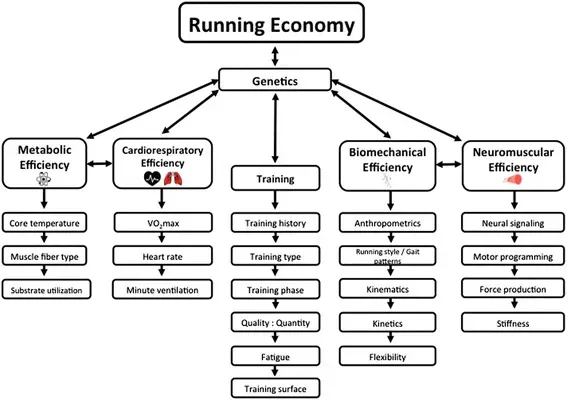Running economy is a crucial concept within the realm of athletic performance, particularly for long-distance runners seeking efficiency. At the forefront of this evolution are innovative technologies like super shoes, designed to enhance running performance through advanced features such as carbon plates and state-of-the-art foam cushioning. By optimizing running economy, athletes can improve their speed and endurance without exerting additional energy, leading to better race results. Notably, the Puma Fast-R Nitro Elite 3 exemplifies the cutting-edge design that characterizes modern athletic footwear, blending comfort with scientific precision. As sports science continues to explore the intricacies of human movement, understanding running economy will become increasingly vital for both elite and everyday runners looking to achieve their personal bests.
The concept of running economy refers to the efficiency with which a runner uses energy during their stride, fundamentally influencing performance outcomes. Many athletes leverage high-tech footwear, commonly referred to as “performance shoes,” which incorporate features to enhance this efficiency. Innovations, including responsive foam technology and supportive structures, enable runners to maintain better energy conservation throughout their races. As discussions around optimal footwear grow, understanding the mechanics behind these advancements is essential for any serious runner. The Puma Fast-R Nitro Elite 3, alongside other similar models, illustrates the blend of innovation and performance demanded in today’s competitive running landscape.
Understanding Running Economy
Running economy is an essential measurement in the world of athletics, particularly for long-distance runners. It refers to the amount of energy required to maintain a certain speed, and in simple terms, it’s about efficiency. The more economically a runner can move, the less energy they expend, which can lead to significantly better performance over long distances. This concept has been increasingly integrated into the development of advanced footwear technologies, especially super shoes featuring carbon plates and responsive foams. These innovative designs are tailored to improve running economy, allowing athletes to conserve energy and maintain speed throughout their races.
To understand running economy fully, one must consider factors like oxygen uptake and biomechanics. During lab testing, scientists measure how efficiently oxygen is utilized during a run, which is crucial for performance. The relationship between the runner and their gear plays a significant role: an effective super shoe can enhance your biomechanics, enabling more efficient movement patterns. Sports scientists like Wouter Hoogkamer emphasize that while running faster might seem like the primary goal, improving running economy can yield greater benefits—resulting in less fatigue and ultimately faster finishing times during races.
The Impact of Super Shoes on Performance
Super shoes, notably those equipped with carbon plates like the Puma Fast-R Nitro Elite 3, have revolutionized running performance. These shoes are engineered to not just support but enhance every stride a runner takes. The combination of lightweight construction, cushioned midsoles, and stiff carbon plates creates a potent mix that can significantly improve a runner’s speed and efficiency. As runners test these shoes in various environments, the feedback is overwhelmingly positive, often reporting enhanced comfort and responsiveness, which collectively contribute to an improved running economy.
The phenomenon behind super shoes isn’t merely a marketing gimmick; it’s grounded in sports science. Detailed studies have shown that these advanced shoes can provide measurable benefits, such as improved running economy, which can give runners an edge during competitive events. For example, lab tests consistently reveal that runners wearing super shoes exhibit lower energy expenditure at race pace. This efficiency allows athletes not only to maintain speed but also to tackle the latter stages of a race with less fatigue, ultimately leading to improved finishing times.
The Science Behind Carbon Plate Technology
Carbon plate technology is one of the most significant innovations in running footwear, particularly seen in modern super shoes. The carbon plate acts as a lever, propelling the runner forward at every push-off phase of the gait cycle, which is particularly crucial for maximizing running economy. By increasing propulsion and enhancing energy return from the shoe, athletes can maintain higher speeds with less exertion. This technology is not just theoretical; rigorous testing in controlled environments shows that it can lead to measurable improvements in performance.
Furthermore, the incorporation of such high-tech materials allows super shoes to adapt more dynamically to a runner’s foot movement. A comfortable and responsive fit means less wasted energy during strides, culminating in a more sustainable performance throughout races. Brands like Puma have invested heavily in sports science to ensure that their super shoes, such as the Fast-R Nitro Elite 3, align with these principles of biomechanics and efficiency, making them a game-changer for serious runners aiming to break personal records.
Exploring the Testing Protocols of Super Shoes
The testing protocols used to evaluate super shoes are as robust as the footwear itself. At Puma’s Nitro Lab, for example, athletes undergo a series of tests designed to measure various aspects of their running performance. This includes evaluating running economy through oxygen uptake measurements while simulating marathon paces. These controlled conditions ensure that the results reflect true performance dynamics, allowing researchers to draw accurate conclusions about the efficacy of the super shoe features such as the carbon plate and advanced foams.
Athletes complete rounds in both standard running shoes and super shoes, facilitating a direct comparison of performance metrics. By analyzing the data collected—like step length, force of impact, and propulsion—scientists gain insights not just about the shoes’ inherent benefits but also how individual runners can optimize their performance. It’s a fascinating blend of athleticism and scientific precision that ultimately helps brands like Puma further their innovations within the running shoe market.
The Role of Sports Science in Running Shoe Development
Sports science plays a pivotal role in the ongoing development of high-performance running shoes. By applying principles of biomechanics and exercise physiology, researchers and developers work together to create footwear that enhances running efficiency. This collaborative effort often involves extensive field tests and laboratory assessments, ensuring that the shoes not only meet the demands of elite runners but also provide substantial benefits to everyday athletes. Understanding the physiological impacts of footwear enables brands to refine their designs, making significant strides in enhancing running economy.
As brands compete to lead the market, sports scientists are continually exploring new materials and technologies that can revolutionize performance. From advanced foams that minimize energy loss to carbon plates that boost propulsion, the synergy between sports science and product development is crucial for pushing the boundaries of what’s possible in running. By focusing on measurable performance gains through rigorous testing, companies strive to provide runners with enhanced capabilities, translating to better results on race day.
Evaluating the Real-World Impact of Super Shoes
While lab tests provide a controlled environment to gauge running economy and shoe efficacy, the real-world impact remains a critical point of discussion. Many runners report feeling more efficient and faster during training and races while wearing super shoes like the Puma Fast-R Nitro Elite 3. These shoes not only promise improved performance through advanced technology but also deliver tangible benefits that can be felt during runs. It’s becoming increasingly common for recreational athletes to embrace these innovations, as they seek similar enhancements that elite runners already experience.
Moreover, the implications of improved running economy can extend far beyond competitive settings. For many individuals, reducing fatigue during runs allows for longer training sessions or more frequent workouts without increased risk of injury. Insights gathered from real-world testing continue to emphasize the importance of shoe choice in an athlete’s training regime. Balancing comfort, support, and performance benefits makes super shoes a compelling option for runners at all levels looking to elevate their game.
Debunking Myths about Super Shoes
As super shoes gain popularity, numerous myths and misconceptions surrounding their performance have emerged. One prevalent myth is that simply wearing super shoes will instantly make anyone faster without considering the runner’s individual skill levels and conditioning. In reality, while these shoes enhance running economy, the athletic capabilities of the wearer play a crucial role in determining overall performance. Runners must still devote time to training and conditioning to harness the full potential of super shoe technology.
Another common misconception is that super shoes are only for elite athletes. However, research suggests that recreational runners can also benefit from the efficiency and support these shoes provide. Engaging in high-quality testing of shoes that improve running form and energy expenditure has shown positive impacts across various skill levels. It’s vital for runners to understand that advancements in shoe technology are designed to help them perform better, regardless of their experience or pace.
Future Innovations in Running Footwear
The running shoe industry is continuously evolving, with new materials and technologies promising to enhance athletic performance even further. Innovations such as ultra-lightweight materials, enhanced breathability, and adaptive designs that conform to individual foot shapes are all trends that are gaining traction. Researchers are tirelessly working to integrate smart technologies into footwear, allowing real-time data tracking of running performance to help athletes make informed decisions about their training regimens.
These advancements are not just about performance; they also emphasize sustainability. The future of running footwear is steering towards eco-friendly materials and production methods, aligning with the growing consumer demand for sustainable products. As brands invest in smart technology and sustainable practices, runners can expect that their super shoes will not only enhance performance but do so in a way that is conscious of environmental impact.
The Psychological Edge of Wearing Super Shoes
Beyond the tangible performance benefits, wearing super shoes can also provide psychological advantages to runners. The belief that you’re equipped with high-tech footwear can boost confidence, potentially leading to improved performance outcomes. This psychological edge is significant, as runners often compete not only against other athletes but also against their mental barriers. Embracing cutting-edge technology can instill a sense of empowerment, fueling the motivation to push past perceived limits.
Moreover, the positive effects of improved running economy can reinforce confidence during races. When runners experience less fatigue and maintain better paces, it can enhance their mindset and overall race experience. As athletes seek greater performance, the psychological aspect of wearing advanced footwear like the Puma Fast-R Nitro Elite 3 plays a vital role. Merging physical performance with mental fortitude gives runners a more comprehensive advantage on race day.
Frequently Asked Questions
What is running economy and how do super shoes impact it?
Running economy refers to the amount of energy required to maintain a steady pace while running. It is crucial for performance as more efficient runners use less oxygen at a given speed. Super shoes, especially those with carbon plates, enhance running economy by improving energy return in each stride, thus allowing runners to conserve energy and reduce fatigue during races.
How do carbon plate shoes improve running performance?
Carbon plate shoes improve running performance through their unique design, which combines a rigid carbon plate with responsive foam. This technology enhances the runner’s push-off during the gait cycle, resulting in a more efficient stride. Consequently, runners experience better running economy, allowing for faster race times and decreased fatigue.
What role do super shoes play in sports science?
In sports science, super shoes represent a significant advancement in running technology, focusing on improving running economy through scientific research. These shoes are tested using specialized protocols in labs, enabling researchers to measure their impact on oxygen consumption and overall efficiency, leading to evidence-based claims about their performance benefits.
What are the key components of Puma Fast-R Nitro Elite 3 that affect running economy?
The Puma Fast-R Nitro Elite 3 features a combination of a carbon plate and advanced midsole foam. These components work together to enhance propulsion during the gait cycle, thus improving running economy. The design allows for a more efficient transfer of energy during each stride, contributing to better endurance and overall performance.
How can runners improve their running economy aside from using super shoes?
Runners can enhance their running economy by incorporating strength training, optimizing their running form, and undergoing specific running workouts to increase efficiency. By improving core strength and engaging in interval training, runners can develop a more effective stride that complements the benefits provided by super shoes like those equipped with carbon plates.
Why is measuring running economy important for marathon runners?
Measuring running economy is vital for marathon runners because it directly correlates with fatigue levels and race performance. A high running economy means a runner can sustain speed with less energy expenditure, leading to better outcomes in long-distance events. Tools used to measure running economy help athletes select the best gear, including super shoes, to maximize their efficiency on race day.
What are the benefits of using the Treadmetrix system for testing running economy?
The Treadmetrix system provides precise measurements of footfall forces, step length, propulsion, and other critical metrics. By using this technology for testing running economy, runners and sports scientists can gather actionable data on shoe performance and individual running mechanics, ultimately guiding training and equipment choices for improved results.
Can improving running economy lead to faster race times?
Yes, improving running economy can significantly lead to faster race times. When runners use less energy at a given pace, they conserve strength for later stages of a race. This means they can maintain their speed or accelerate when it counts, resulting in improved finishing times, particularly evident in long-distance events.
What evidence supports the claims of enhanced running economy with super shoes like Puma Fast-R Nitro Elite 3?
Recent studies, including those conducted at UMass-Amherst, have shown that super shoes such as the Puma Fast-R Nitro Elite 3 can result in substantial improvements in running economy—around 3.6 to 3.7 percent. This evidence underscores the effectiveness of super shoe technology in optimizing performance through enhanced energy efficiency.
How does oxygen uptake relate to running economy and super shoes?
Oxygen uptake is a key measure of running economy. It reflects how efficiently a runner uses oxygen during running. Super shoes help improve running economy by enabling runners to breathe less heavily and consume less oxygen at a given speed, allowing for better endurance and performance in races.
| Key Point | Details |
|---|---|
| Running Economy | Refers to the energy efficiency of runners, important for distance running performance. |
| Measurement Method | Measured by assessing oxygen uptake during running; less oxygen usage indicates better efficiency. |
| Importance of Super Shoes | High-tech shoes improve running economy through design features like carbon plates and responsive foam. |
| Gait Cycle Influence | Super shoes enhance stride efficiency during the mid-stance and terminal stance phases of running. |
| Test Results Summary | Using the Fast-R Nitro 3 improved running economy by 3.7%, suggesting significant potential for improved race times. |
Summary
Running economy is a crucial metric in understanding how efficiently runners perform, particularly when assessing the effectiveness of shoe technology. The testing of super shoes reveals significant improvements in running efficiency, showcasing the advancements in footwear design that can lead to faster marathon times. This is particularly pertinent for performance-oriented runners looking to shave vital seconds off their personal records.



